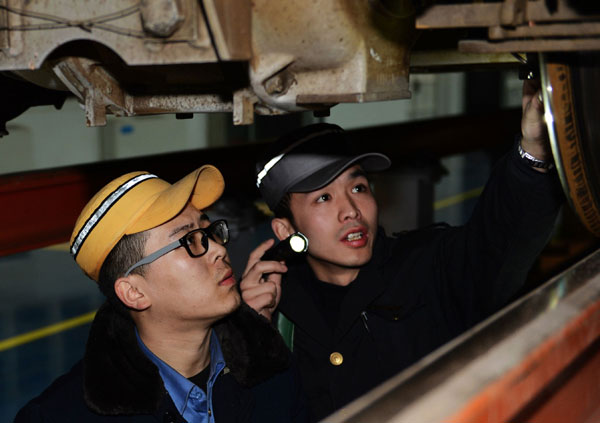"China's railway system has undergone six rises in operating speed and the equipment has been upgraded massively. Safety is still the most important aspect, and no matter what happens, humans are still the most vital factor, especially the drivers," said Li Zhenxiu, Party chief of the CRH Trains Workshop at Zhengzhou Railway Bureau.
"Drivers must fully understand how to employ the new safety apparatus to prevent accidents. Tragedies have occurred because we were not fully aware of how to control the machines and manage emergencies," he said.
Local railway bureaus were responsible for employing train drivers until 2006, when the Ministry of Railways took over the recruitment of bullet-train drivers.
Only 1,000 out of 120,000 employees at the Zhengzhou bureau met the requirements. They were required to have driven 500,000 km without an accident, and had to be younger than 40. Only 50 applicants survived the two rounds of theoretical and practical exams in Zhengzhou, and the number was then whittled down to 10 via rigorous interviews at the ministry.
A further 80 drivers were recruited from around the country to operate trains that, at the time, had a top speed of 200 km per hour, according to Li.
In the last six years, the bureau has trained 90 drivers for high-speed trains. The theoretical training for each driver costs approximately 100,000 yuan ($15,000), said Li. The bureau also sent 30 drivers to Japan and Sweden for further study in 2007.
From May to July 2006, two drivers participated in testing new trains in Qingdao, Shandong province, to pinpoint potential problems before the vehicles went into service. One year later, a further 22 drivers were trained to operate the vehicles.
"The trains were all in use until 11pm and new drivers had to wait until midnight in winter to practice," said Li. "They often had intense arguments about the details, some even became really angry. But the discussions allowed them to find more-effective ways of solving problems. Outside the class, they remained good friends."
 |
|
Workers inspect a high-speed train at the CRH Trains Workshop at Zhengzhou Railway Bureau. All HSR trains are taken to the workshop after they have been in service for 48 continuous hours. Xiang Mingchao / China Daily |
Unlike other training courses, the teachers allowed one hour for discussions that involved every driver. Each of them was required to raise at least one query, otherwise the group wasn't allowed to leave the classroom.
"One must spend at least six years training, from rookie status to being awarded the certificate for high-speed train drivers. When a friend asked me to find his daughter a boyfriend, I had to refuse. I pointed out that our youngest driver was 27 years old, and most of them were already 30 and married," Li said with a smile.
To ensure that the drivers understood that safety is their top priority, Li and his team held 50 emergency programs to educate new recruits. Each driver was required to observe veterans driving 1,000 km, before being allowed to practice for 3,000 km. Now new drivers must have driven a high-speed train for 10,000 km. During the practice, Li's students undertook six round trips each day, from Zhengzhou to Shangqiu, 220 km east of the provincial capital.
"Drivers are not allowed to drive more than four consecutive hours and our drivers hand the train over to a replacement driver in Wuhan. By doing this, the drivers can give the job their full attention and reduce risks," said Li.
Zhang Leilong in Zhengzhou and Zhou Lihua in Wuhan contributed to this story.
Contact the reporters at huyongqi@chinadaily.com.cn and yangwanli@chinadaily.com.cn
